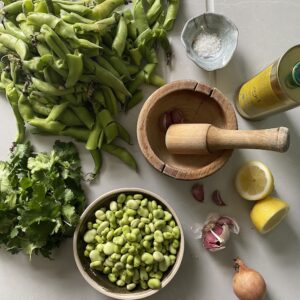broad beans with coriander and garlic
Broad beans with coriander and garlic is a brilliantly simple way of making these precious seasonal beans into a stand-alone dish. Instead of serving them as a steamed or boiled side dish, the coriander and garlic give the dish more authority on the table! Revered in Lebanon, during the season truck loads can be seen beside the roads selling kilos of broad beans. Since the local currency in Lebanon has lost 90% of its value, many Lebanese are now growing vegetables at home to be able to enjoy this summertime staple.
This dish seems to sum up the eastern Mediterranean way of cooking vegetables. Simple ingredients, quickly cooked to preserve nutrients, using herbs and garlic to enhance flavour. I first remember eating this dish in Damascus, while learning Arabic there. My teacher often generously provided lunch. Having only ever had boiled broad beans before, this dish served warm with yoghurt and bread, was a revelation.
We’ve chosen a meat-free version, since it’s quicker to cook. Following Barbara Massaad‘s recipe in her cook book Mezze, blanching the beans for 2 minutes before plunging them into ice cold water to stop the cooking, keeps the colour. When quickly tossed in the frying pan with garlic and coriander, the broad beans should remain bright green. You may need to keep the beans in the pan with the coriander and garlic a little longer if your beans are larger.
serve
ingredients
1kg broad beans, podded, to get about 240g or use frozen ones
a small bunch of coriander (15g) leaves picked and chopped finely
3 garlic cloves, crushed with 1/2 tsp salt
2 tbsp Zejd’s extra virgin olive oil and more for drizzling
method
- Put a pan of water on to boil while you pod the beans. Once boiling, add the podded beans and leave for 2 minutes. Drain and submerge the beans into ice cold water to stop them cooking. Once cool, drain.
- Warm the extra virgin olive oil in a frying pan on a low flame and add the crushed garlic.
- Once the garlic smells fragrant, add the chopped coriander and move around the pan. Then tip in the beans and stir so that the beans are well covered in garlic and coriander add more extra virgin olive oil if it’s looking too dry. You may need to cover with a lid for larger beans to give them a bit of extra cooking. Remove from the pan and place in a serving dish. A squeeze of lemon is nice too.
Best eaten at room temperature with a pool of Zejd’s extra virgin olive oil trickled over them, and a helping of thick Greek yoghurt with flat breads to scoop up each mouthful.
postscript
Nada Saleh in New Flavours of the Lebanese Table includes a recipe using the whole pod with meat. We’ve done a similar recipe using young broad beans but without meat, and although the colour was less appealing, it was none the less delicious and at least you will benefit from the fibre!
- Wash and string the broad beans, then chop into 3cm lengths.
- Sweat a small onion, and once golden and soft add the cut up beans and 100ml of water. Put a lid on and leave on a low heat for 10 minutes, checking to make sure there’s enough water half way through. When they are tender, turn off the flame.
- In another frying pan add a tablespoon of oil, when warm add the garlic, stirring to make sure it doesn’t burn. Then scatter over the chopped coriander stirring so that nothing sticks. Once fragrant, stir this into the pan with the broad beans, making sure that the beans are well covered.
Serve warm, with generous amount of Zejd’s extra virgin olive oil for a quick lunch served with a squeeze of lemon and flat breads. They won’t maintain their vivid green, but at least your diet will benefit from the fibre!
